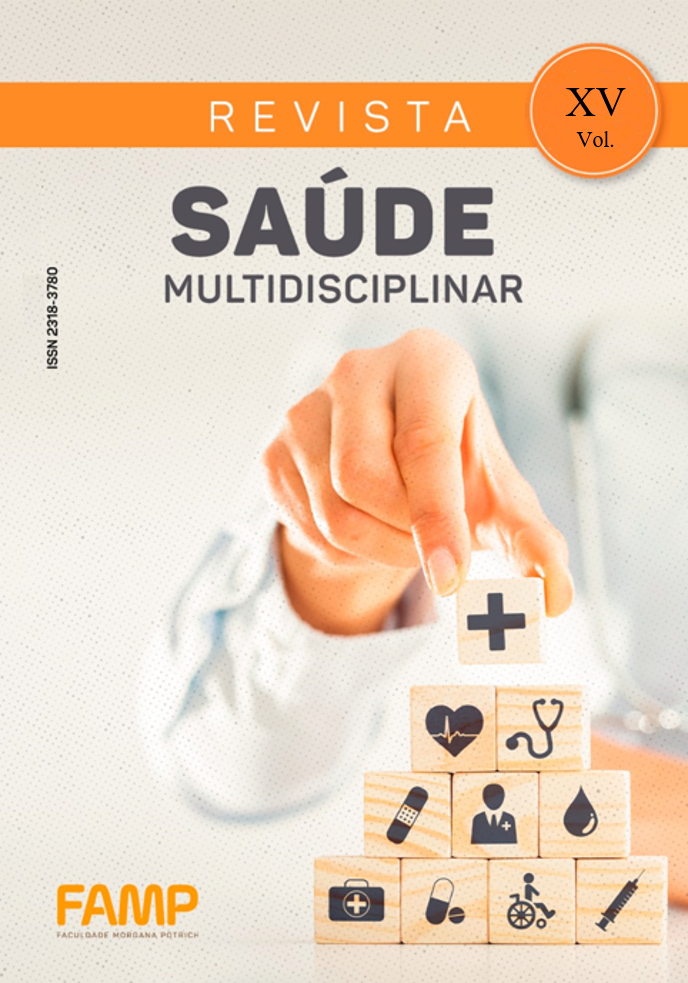Nervous system and spinal cord injury
a literature review
DOI:
https://doi.org/10.53740/rsm.v15i2.664Keywords:
Spinal Cord, Nervous System, Central Nervous System, Peripheral Nervous SystemAbstract
The nervous system is one of the most complex structures of the human organism, being responsible for the processing and integration of sensory, motor, and cognitive information. Spinal cord injury (SCI) constitutes any damage to the neuronal elements that can result in complications below the damaged segment. It is a devastating condition that can result in temporary or permanent functional disability to the individual. In this sense, this study aims to analyze the literature regarding the nervous system and SCI. As a result, it is presented in a descriptive way how the nervous system is composed, its structures, functions, and mechanisms, as well as the impact of spinal cord injury on the health and functionality of the affected individual, clarifying the main forms of treatment to promote quality of life to the population that experiences this condition. The relevance of the research with the information apparatus goes against the contribution to professional practice, especially to those who work in the neurofunctional area.
References
Haines D. E. Neurociência fundamental para aplicações básicas e clínicas. Filadélfia: Elsevier - Divisão de Ciências da Saúde; 2006.
Bear M. F., Connors B. W., Paradiso M. A. Neurociências: desvendando o sistema nervoso. Porto Alegre: Artmed; 2017.
Kandel E. R., Schwartz J. H., Jessell T. M. Princípios da Neurociência. 5ª ed. Porto Alegre: Artmed; 2014.
Guyton A. C., Hall J. E. Tratado de fisiologia médica. 13ª ed. Rio de Janeiro: Elsevier; 2017.
American Spinal Injury Association. International standards fo neurological classification of spinal cord injury. Richmond: American Spinal Injury Association; 2019.
Khorasanizadeh M., Yousefifard M., Eskian M., Lu Y. et al. Neurological recovery following traumatic spinal cord injury: a systematic review and meta-analysis. J Neurosurg Spine, 2019, 15:1-17.
National Spinal Cord Injury Statistical Center. Spinal Cord Injury Facts and Figures at a Glance Birmingham. Alabama: National Spinal Cord injury Statisical Center; 2016.
Rayegani S. M., Tavanaei R., Oraee-Yazdani S. Principles of Rehabilitation Strategies in Spinal Principles of Rehabilitation Strategies in Spinal Cord Injury. Paraplegia - New Insights [Working Title]. IntechOpen; 2023.
Organização Mundial de Saúde. International Perspectives on Spinal Cord Injury. Genebra: WHO; 2013.
Juvenal E. A., Savordelli C. L. A eficácia do cicloergômetro no condicionamento cardiovascular em pacientes com lesão medular. Rev Soc Bras Clin Med, 2016; 14(3):151-155.
Mendes K. D. S., Silveira R. C. C. P., Galvão C. M. Revisão Integrativa: método de pesquisa para a incorporação de evidências na saúde e na enfermagem. Texto e Contexto - Enfermagem, 2008; 17(4): 758-764.
Dias E. W., Naves M. M. L. Análise de assunto: teoria à prática. 2ª ed. Brasília: Thesaurus; 2013.
Moore K. L., Dalley A. A. Anatomia orientada para a clínica. 8ª ed. Rio de Janeiro: Guanabara Koogan; 2018.
Moore K. L., Persaud T. V. N. Embriologia clínica. 10ª ed. Rio de Janeiro: Elsevier; 2019.
Schoeller S., Martini A. C., Forner S., Nogueira G. C. Abordagem multiprofissional em lesão medular: saúde, direito e tecnologia. Florianópolis: Publicação do IFSC; 2016.
CORRÊA, M. C. S. M. Anatomia e Fisiologia. Paraná: Instituto Federal de educação, ciência e tecnologia; 2016.
Furlan JC, Sakakibara BM, Miller WC, Krassioukov AV. Global incidence and prevalence of traumatic spinal cord injury. Can J Neurol Sci, 2013; 40(4):456-64.
BRASIL. Ministério da Saúde. Secretaria de Atenção à Saúde. Departamento de Ações Programáticas Estratégicas. Diretrizes de Atenção à Pessoa com Lesão Medular. Brasília, DF: Ministério da Saúde, 2013.
Ahuja C. S., Nori S., Tetreault L., Wilson J. et al. Traumatic spinal cord injury - repair and regeneration. Neurosurgery, 2017; 80(3):9-22.
Loy K., Bareyre F. M. Reabilitação após lesão da medula espinhal: como os modelos animais podem ajudar nossa compreensão da neuroplasticidade induzida pelo exercício. Regeneração Neural Res, 2019; 14:405–412.
Zheng Y., Mao Y. R., Yuan T. F., Xu D. S. et al. Multimodal treatment for spinal cord injury: a sword of neuroregeneration upon neuromodulation. Neural Regeneration Research, 2020; 15(8):1437-1450.
Ramadan W. S., Abdel-Hamid G. A., Al-Karim S., Zakar N. A. M. B. et al. Neuroectodermal stem cells: A remyelinating potential in acute compressed spinal cord injury in rat model. Journal of biosciences, 2018; 43:897-909.
Leister I., Haider T., Mattiassich G., Kramer J. L. et al. Biomarkers in traumatic spinal cord injury—technical and clinical considerations: a systematic review. Neurorehabilitation and Neural Repair, 2020; 34(2):95-110.
Chen J. M., Li X. L., Pan Q. H., Yang Y. et al. Effects of non-invasive brain stimulation on motor function after spinal cord injury: a systematic review and meta-analysis. Journal of NeuroEngineering and Rehabilitation, 2023; 20(1):1-19.
Biblioteca Nacional de Medicina dos EUA. Baclofeno. StatPearls [Internet]. 2022. Disponível em: <https://www.ncbi.nlm.nih.gov/books/NBK459333/> Acesso em: 03 de maio de 2023.
Cardenas D. D., Nieshoff E. C., Suda K., Goto S. I. et al. A randomized trial of pregabalin in patients with neuropathic pain due to spinal cord injury. Neurology, 2013; 80(6):533-539.
Forte G., Giuffrida V., Scuderi A., Pazzaglia M. Future Treatment of Neuropathic Pain in Spinal Cord Injury: The Challenges of Nanomedicine, Supplements or Opportunities? Biomedicines, 2022; 10(6):1-4.
Samal V., Paldus V., Fackova D., Mecl J. et al. The prevalence of antibiotic-resistant and multidrug-resistant bacteria in urine cultures from inpatients with spinal cord injuries and disorders: an 8-year, single-center study. BMC infectious diseases, 2022; 22(10):1-11.
Almeida R. L. D. Avaliação do impacto clínico e financeiro da modificação de protocolo de profilaxia de tromboembolismo venoso em pacientes com lesão medular traumática e não traumática em um centro de reabilitação de referência no Brasil. [Dissertação de Mestrado]. Brasília: Universidade de Brasília; 2018. 89 p.
Gerber L. H., Deshpande R., Prabhakar S., Cai C. et al. Narrative Review of Clinical Practice Guidelines for Rehabilitation of People With Spinal Cord Injury: 2010–2020. American Journal of Physical Medicine & Rehabilitation, 2021; 100(5):501-512.
Duan R., Qu M., Yuan Y., Lin M. et al. Clinical benefit of rehabilitation training in spinal cord injury: A systematic review and meta-analysis. Spine, 2021; 46(6):398-410.
Rosley N., Hasnan N., Hamzaid N. A., Davis G. M. et al. Effects of a combined progressive resistance training and functional electrical stimulation-evoked cycling exercise on lower limb muscle strength of individuals with incomplete spinal cord injury: A randomized controlled study. Turk J Phys Med Rehab, 2023; 69(1):23-30.
Associação Brasileira de Fisioterapia Neurofuncional (ABRAFIN). Fisioterapia Neurofuncional na Lesão Medular. 2021. Disponível em: <https://abrafin.org.br/fisioterapia-neurofuncional-na-lesao-medular/>. Acesso em: 25 mar. 2023.
Takahashi K. Z. Rehabilitation strategies for functional improvement after spinal cord injury: a review of literature. Revista Brasileira de Ortopedia, 2018; 53(3):249-255.
Mouro A. M., Barreto L. S. G., Dantas R. A. S., Barros P. B. F. Fisioterapia na lesão medular: uma revisão integrativa. Revista Neurociências, 2021; 29(2):1-20.
Additional Files
Published
How to Cite
Issue
Section
License
Copyright (c) 2023 REVISTA SAÚDE MULTIDISCIPLINAR

This work is licensed under a Creative Commons Attribution-NonCommercial-NoDerivatives 4.0 International License.









